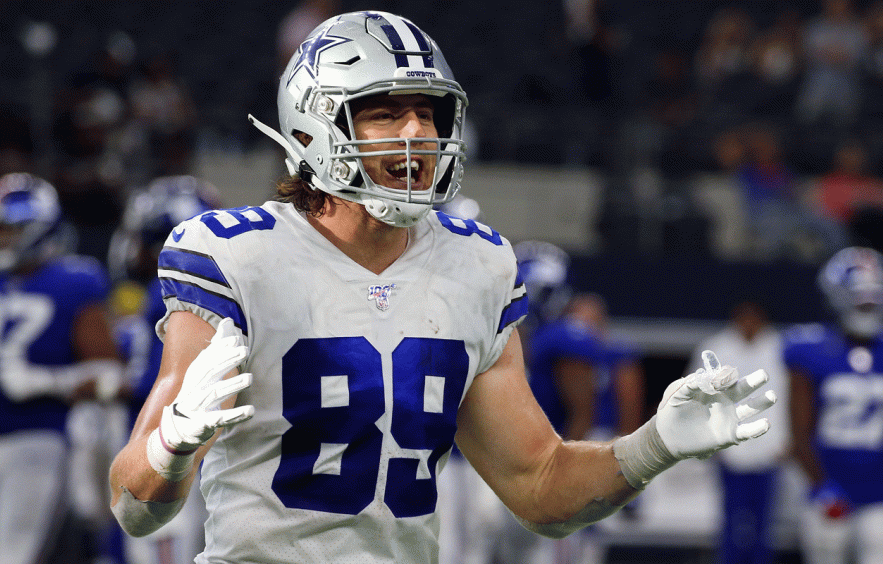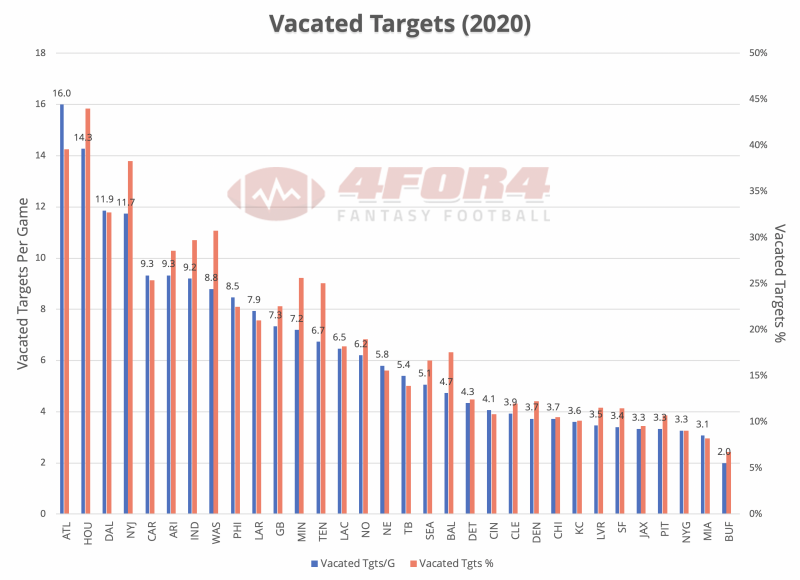Using Vacated Targets to Identify Opportunity (2020)

Opportunity is one of the major factors I consider as I evaluate free agent signings and trades, and attempt to identify impact rookies in any given season. For years, I gauged this opportunity holistically—e.g. DeAndre Hopkins was (ponderously) traded away, so there is major opportunity in Houston—but last season I thought I’d go through the process of calculating vacated targets to see if it would identify opportunity that wasn’t readily apparent.
Note: On Wednesday, April 22, at 10 AM Pacific I'll be doing a chat on my Instagram [link] to discuss both the vacated targets and vacated touches articles.
Looking back at that (pre-NFL Draft) article, it appears that my work did identify opportunity even if I didn’t always correctly identify the biggest beneficiaries on each team:
-
The Raiders topped the list in vacated targets and Darren Waller was the breakout star, though Tyrell Williams had his moments prior to injuring his foot.
-
The Ravens’ vacated targets were misleading due to the midseason quarterback switch from Joe Flacco to Lamar Jackson, but it was Mark Andrews who picked up much of the remaining slack.
-
There was opportunity available in Jacksonville and it was D.J. Chark who took advantage en route to a No. 16 finish in half-PPR formats. I had a number of subscribers thank me for ranking Chark higher than my peers.
-
The Steelers had a lot of targets up for grabs after Antonio Brown’s departure, though the injury to Ben Roethlisberger drastically reduced the value of those targets. To a certain extent, James Washington and Diontae Johnson both took advantage.
-
The extra targets up for grabs in Tampa led to Chris Godwin’s No. 2 overall finish as his targets jumped from 5.9 to 8.6 per game.
-
The opportunity available in Buffalo led to solid fantasy seasons from both John Brown and Cole Beasley.
-
The Jets showed up in the top third of the table and Jamison Crowder’s production in 13 games with Sam Darnold (5.4-58-0.46 on 8.3 targets per game) was the result. Robby Anderson's production also spiked at the end of the season.
-
Towards the bottom of the table, I was able to identify Cleveland as a source of concern due to the arrival of Odell Beckham and only 2.9 vacated targets per game. I thought it would be Jarvis Landry and David Njoku who would suffer, but Beckham’s usage was lower than expected and he turned in a disappointing, low-end fantasy WR2 season, while Landry mostly maintained his workload. As always, beware of receivers changing teams unless they are getting a promotion in usage (an increase in targets) or an upgrade at quarterback. We thought Baker Mayfield was that upgrade, but he wasn't any better than late-model Eli Manning in 2019.
Given injuries, trades and Week 17 weirdness, I realized last year that it’s a little tricky to calculate total vacated targets, but I think the numbers below provide a good roadmap to find 2020 opportunity in the passing game.
Included are targets per game and the share of targets vacated through Week 16. I also pulled in the fantasy value of the targets based on the (presumed) starting quarterback’s fantasy point per pass attempt from the last two years and multiplied that by the vacated targets per game to find the implied fantasy points up for grabs for each team. For Cincinnati and New England, I used the average of the bottom 15 quarterbacks since we don’t have a good idea who will be their starters in 2020.
| Team | Vacated Tgts/G | Vacated Tgts % | Key Additions | Implied FP (half-PPR) |
|---|---|---|---|---|
| ATL | 16.0 | 39.6% | Todd Gurley, Hayden Hurst, Laquon Treadwell | 22.5 |
| HOU | 14.3 | 44.0% | Brandin Cooks, Randall Cobb, David Johnson | 20.7 |
| DAL | 11.9 | 32.7% | Blake Bell | 16.5 |
| NYJ | 11.7 | 38.3% | Breshad Perriman | 14.6 |
| CAR | 9.3 | 25.4% | Robby Anderson, Seth Roberts, Pharoh Cooper, Seth Devalve, Keith Kirkwood | 12.1 |
| ARI | 9.3 | 28.6% | DeAndre Hopkins | 11.5 |
| IND | 9.2 | 29.7% | - | 13.3 |
| WAS | 8.8 | 30.8% | Peyton Barber, Cody Latimer, Logan Thomas, J.D. McKissic, Marcus Baugh | 10.3 |
| PHI | 8.5 | 22.5% | - | 11.2 |
| LAR | 7.9 | 21.0% | - | 10.9 |
| GB | 7.3 | 22.5% | Devin Funchess | 9.5 |
| MIN | 7.2 | 25.7% | Tajae Sharpe | 10.2 |
| TEN | 6.7 | 25.1% | - | 10.8 |
| LAC | 6.5 | 18.2% | Darius Jennings | 8.3 |
| NO | 6.2 | 19.0% | Emmanuel Sanders | 9.8 |
| NE | 5.8 | 15.6% | Damiere Byrd | 7.4 |
| TB | 5.4 | 13.9% | - | 7.0 |
| SEA | 5.1 | 16.7% | Phillip Dorsett | 7.9 |
| BAL | 4.7 | 17.6% | - | 7.2 |
| DET | 4.3 | 12.5% | Geronimo Allison | 5.9 |
| CIN | 4.1 | 10.9% | Geremy Davis | 5.2 |
| CLE | 3.9 | 12.0% | Austin Hooper, Jojo Natson | 5.3 |
| DEN | 3.7 | 12.3% | Melvin Gordon, Nick Vannett | 4.6 |
| CHI | 3.7 | 10.5% | Jimmy Graham, Demetrius Harris | 4.6 |
| KC | 3.6 | 10.1% | Ricky Seals-Jones | 5.8 |
| LVR | 3.5 | 11.6% | Jason Witten, Nelson Agholor, Nick O'Leary, Rod Smith | 4.6 |
| SF | 3.4 | 11.5% | Travis Benjamin | 5.1 |
| JAX | 3.3 | 9.6% | Tyler Eifert | 4.2 |
| PIT | 3.3 | 10.8% | Eric Ebron | 4.5 |
| NYG | 3.3 | 9.1% | Levine Toilolo, Dion Lewis, Eric Tomlinson | 4.2 |
| MIA | 3.1 | 8.2% | Jordan Howard | 4.3 |
| BUF | 2.0 | 6.7% | Stefon Diggs, Taiwan Jones | 2.3 |
Here's the data in chart form:

Players to Keep An Eye On
-
Did you know there is a boatload of targets up for grabs in Atlanta? Well, now you do. The departure of Austin Hooper and Devonta Freeman, along with the midseason trade of Mohamed Sanu, means that 16.0 targets per game are available to newcomers Hayden Hurst (who looks like a great late-round value) and Todd Gurley.
-
The DeAndre Hopkins trade opened up a ton of work in Houston, and the Texans acquired Brandin Cooks, Randall Cobb and David Johnson to pick up the slack. Way to go, Bill O'Brien.
-
With Cobb and Jason Witten out in Dallas, look for Blake Jarwin and Michael Gallup to emerge as every-week fantasy starters.
-
The departure of Robby Anderson means that Jamison Crowder should continue to produce in PPR formats, but don’t forget about newcomer Breshad Perriman. Last season, the former first-rounder ended up with 36-645-6 on 69 targets in Tampa, finishing the season with 5-87 (on six targets), 3-70-1 (5), 5-113-3 (6), 7-102 (12) and 5-134-1 (8) in an increased role thanks to injuries to Mike Evans and Chris Godwin. Perriman should see as many targets as he can handle in a complementary role to Crowder, assuming the Jets don't draft a new WR1 this week.
-
Carolina’s 9.3 targets per game include Greg Olsen’s share, most of which will probably go to Ian Thomas, so it’s unclear how Robby Anderson’s arrival will impact the other Carolina receivers, but it doesn’t look good for Curtis Samuel.
-
Arizona also has 9.3 targets per game up for grabs, but DeAndre Hopkins figures to see all of that work (or even more) as he joins the Cardinals’ passing game.
-
One important note on the Colts: My numbers show 9.2 vacated targets per game, but as the Colts shift gears from Jacoby Brissett to Philip Rivers, the overall passing pie should be much larger. Rivers generated 805.8 fantasy points for his receivers in 2019 while Brissett played at a 606-point pace. That means that Rivers could generate around 33% more fantasy points for the Indy receivers in 2020. This is great news for T.Y. Hilton and Jack Doyle, but there is room for another receiver to enter fantasy starter territory with Rivers under center.
-
The Eagles (8.5 T/G), Rams (7.9) and Titans (6.7) all have a modest amount of vacated targets but there have been no major additions to those passing games thus far. If healthy, DeSean Jackson figures to get most of that work in Philadelphia, while Robert Woods, Cooper Kupp and Tyler Higbee stand to benefit in L.A. Maybe the Rams will run more two-TE sets and Gerald Everett will finally become a fantasy starter. In Tennessee, Jonnu Smith should see an uptick in targets and A.J. Brown could see a bona fide WR1 role as well.
-
Once again, I’m worried about Cleveland (3.9 vacated targets per game) as a landing spot for a high-target TE like Austin Hooper. The Browns now have to feed Beckham, Landry, Hooper and perhaps Njoku in the passing game, and new HC Kevin Stefanski was very run-heavy as the offensive coordinator in Minnesota. If Landry’s hip isn’t good to go for Week 1, it might boost Beckham and Hooper for a while, but I'm steering clear of the Browns right now.
-
Pittsburgh may be a better landing spot for Eric Ebron than the numbers currently say, since a healthy Ben Roethlisberger should be a major boost to the passing game. He has led all tight ends in touchdowns over the past two seasons.
-
Like last year with the Browns and Beckham, there is a very worrisome pair of names at the bottom of the table: Stefon Diggs and the Bills. There are only 2.0 vacated targets per game in Buffalo, but there is a glimmer of hope for Diggs: There were 5.3 targets per game available to WRs not named John Brown or Cole Beasley and Diggs is enough of an alpha dog that he’s likely to eat into Brown and Beasley’s workload. Still, I’ll be hard-pressed to find more than 110-120 targets for Diggs in Buffalo.






















